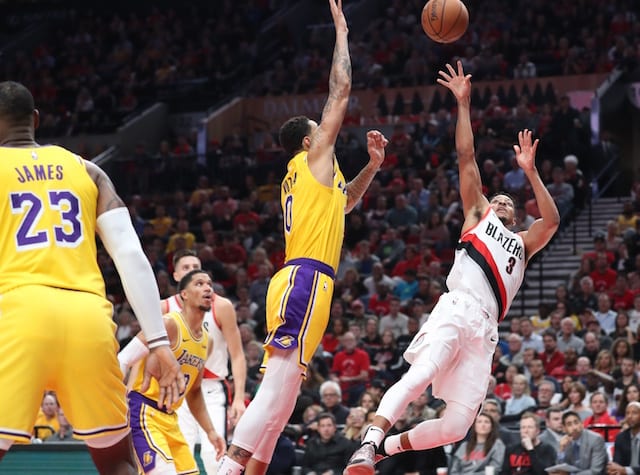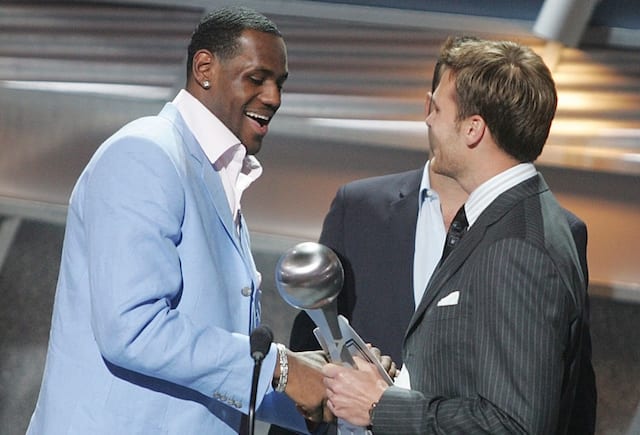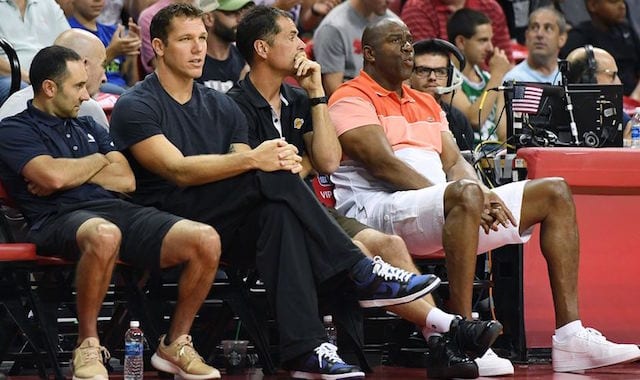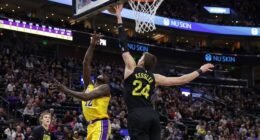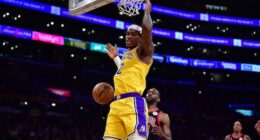The Los Angeles Lakers 2018-19 season didn’t get off the start that they were hoping for, falling to the Portland Trail Blazers, 128-119. Of course, LeBron James was the big story heading into the night and he didn’t disappoint with 26 points, 12 rebounds and 6 assists, but a win just wasn’t in the cards.
Let’s dig into some takeaways from the first game of what should be a thrilling new season of Lakers basketball.
Zigging Instead Of Zagging: Late in the fourth quarter, with the Lakers trailing and the chances of a comeback dwindling, James sailed a pass straight out of bounds, thinking that Kyle Kuzma was going to pop out behind the three-point line rather than cut to the basket.
It was just one play but it was indicative of how difficult it is to get five players on the same page. This Lakers team is very much in its infancy.
They are figuring out roles and tendencies as they work to become a cohesive unit, and that doesn’t happen overnight. Basketball is a simple sport on the surface but the little things add up to a lot.
The Blazers, on the other hand, largely brought back their entire team from last season. They defended well and then made adjustments in the second half seamlessly, inserting the fairly mobile Zach Collins at center and enjoying the difference that his shot blocking made in the paint against a Lakers team that couldn’t get their threes to fall (more on that later).
They have their roles figured out, knowing exactly where everyone on the floor will be. If a Laker got beat on the perimeter and the help defense rotated over Portland knew where to ping the next pass to in order to get the Lakers scrambling and eventually hit the jackpot on a wide-open three.
These things take time. Despite being a talented team, chemistry matters in basketball, and it’s going to be a process as the Lakers figure out the right combinations on the floor.
Three-Point Shooting: For much of the game the Lakers couldn’t get their outside shots to drop. At all.
One of the major criticisms of the roster was that, despite finishing 29th in the league in three-point percentage (34.5%) in 2017-18, they didn’t add anyone in the offseason that would help rectify that problem.
Historically, teams built around James have prioritized shooters who can spread the floor but Lakers president of basketball operations Magic Johnson and general manager Ron Pelinka went a different direction, instead finding playmakers like Rajon Rondo and Lance Stephenson with the goal of taking some of the burden of creating offense off of James’ broad shoulders.
The Lakers did nothing to quiet the concerns about their shooting when they started the game 0-for-15 from beyond the arc. Shot after shot rimmed out, while on the other side of the floor, Nik Stauskas was going crazy, hitting his first six shots and finishing 5-of-8 from deep.
Defensively, the Lakers struggled to stick with him, which played a large part in their ultimate defeat. After all, giving up nearly a combined 50 points to Damian Lillard and C.J. McCollum is almost a given, but allowing a role player like Stauskas to also blow up for 24 points of his own makes winning extremely unlikely.
Stauskas’ barrage had the added insult of throwing the Lakers’ own lack of shooting into sharp contrast as they misfired on one shot after another.
That said, the sample size is extremely small. Despite starting 0-of-15 from three, the Lakers aren’t really that bad from outside. In fact, they hit seven out of their next 15, which helped keep a faint glimmer of hope alive down the stretch.
They did a fine job generating open looks but the Lakers ability to knock them down will be something to watch as the season goes on.
Small Ball: Beyond shooting, the Lakers’ other major gamble this offseason came at the center position. They opted to focus on bringing in wing players rather than bigs with the idea that they can get away with playing small by being fast and running the break.
JaVale McGee (13 points, 8 rebounds, 3 blocks) has done a commendable job in the paint, but only Ivica Zubac and Moritz Wagner (who is still recovering from injury) qualify as true reserve centers.
The Lakers got away with going small last season largely due to the bruising versatility of Julius Randle. They have asked Kyle Kuzma to take on a similar role this season, to mixed results so far.
Kuzma lacks the raw strength of Randle, who could hold his own battling for rebounds with true bigs. This means that the team is betting that Kuzma’s floor spacing and shooting can more than make up for what they give up on the boards.
Against the Blazers, going small didn’t pay off as Kuzma hit just 5-of-15 shots and 1-for-7 from three while the Blazers out-rebounded the Lakers, 54-46, including 14 big offensive boards. If the Lakers are going to play small they need to be able to at least keep things close in the rebounding department while capitalizing on their speed advantage.
That said, it’s way too early to consider the Kuzma-at-center experiment a failure. During the first half, when the Blazers deployed the plodding Jusuf Nurkic against Kuzma, the Lakers were indeed able to run off several high-reel fast breaks while almost staying even in the rebounding department.
While Kuzma’s outside shot wasn’t falling he did make a few quick, nimble cuts and fakes in the paint that the Blazers struggled to deal with.
Whether or not the Lakers can make small ball work is yet to be seen but it’s something the team isn’t going to give up on just yet.
Want to get your content COMPLETELY AD FREE? Follow us on Apple News!
